Instruments
-
Schubert – Erlking – Duo (Vo, Vc, Va, or Afl with Pf)
Erlkönig, by Franz Schubert
Arranged for Cello (or Viola or Alto Flute) and Piano by John W. Pratt
Piano Score and Parts for Cello/Voice, Viola, and Alto Flute; PDF $11.99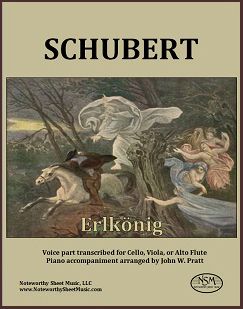 Franz Schubert (1797-1828), inspired by reading Goethe's poem, wrote his song "Erlkönig" in a few hours in 1815. The song was an immediate hit, and continues to be popular to the present day. John Pratt has created a trio arrangement for flute, cello, and piano (click for more information), and also the duo version offered here with Schubert's solo voice part transposed for cello (or viola or alto flute), and with a less arduous alternative to Schubert's piano accompaniment.
Franz Schubert (1797-1828), inspired by reading Goethe's poem, wrote his song "Erlkönig" in a few hours in 1815. The song was an immediate hit, and continues to be popular to the present day. John Pratt has created a trio arrangement for flute, cello, and piano (click for more information), and also the duo version offered here with Schubert's solo voice part transposed for cello (or viola or alto flute), and with a less arduous alternative to Schubert's piano accompaniment.Excerpted from Mr. Pratt's © preface:
"In the duo arrangement, Schubert's solo part is adopted without change. Thus the piano must provide the entire accompaniment, but rocking triplets and other pianistically felicitous passagework replace Schubert's unremitting repetition. The range of sonorities is also wider than Schubert's, though more restrained than that of the trio arrangement, where the flute enlarges the musical terrain. This accompaniment is offered as a less punishing alternative to Schubert's, to be played with a singer or any solo instrument. Solo parts are provided for voice or cello, viola, and alto flute."
Preview
Piano score, 6 pages; Cello, Viola, and Alto Flute parts, 2 pages each; Total, 22 pages.
We also offer a printed hard copy edition of Erlking for $20.38 plus a $5.95 shipping and handling fee to addresses in the USA. Please use the Contact Us form to let us know which hard copy publication(s) you would like to purchase, along with your email contact information and USPS mailing address. We will then send you a PayPal invoice for the sale and, once we receive notice from PayPal that you have paid for the item(s), we will ship your music to the address provided.
-
Bloom - From the Drawer - Tenor or Soprano, Flute, Clarinet, Bassoon, Horn
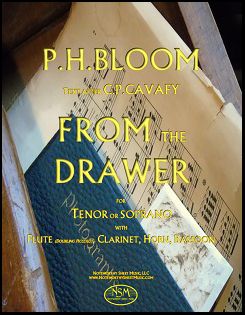 From the Drawer, by Peter H. Bloom
From the Drawer, by Peter H. BloomContemporary Composition for Tenor or Soprano, with Flute (doubling Piccolo), Clarinet in B-flat, Bassoon, and Horn in F
Score and Parts, PDF $13.99
Peter H. Bloom is a Boston-based flutist, whose original compositions and arrangements are published by Noteworthy Sheet Music. From the Drawer was written for Tenor or Soprano, with Flute (doubling Piccolo), Clarinet, Bassoon, and Horn, and provides a musical setting for the intensely emotional poem by Constantine Cavafy.
Here are Peter Bloom's comments about From the Drawer from the composer's preface (Copyright © 2015) to the edition:
"Constantine Cavafy’s 1923 poem, From the Drawer, captures the acerbic condition of longing, the impossibly private nature of affection, and the occultation of time. Its poignancy is universal; transcending gender, age, era, place, and even translation. Rather than rely on one particular translation of Cavafy’s text, I’ve drawn on a number of versions to arrive at a paraphrase that both informs and is shaped by the musical score.
The musical setting is a sonic image of the intensely emotional response to a flood of memory that informs the poet’s narrative: now pensive, now anxious, now wistful, now joyous, now fraught, now resigned, and ever mercurial." P. H. Bloom, September 19, 2015
Our sheet music edition of From the Drawer was featured on the New Products page of the Summer 2016 edition of "The Flutist Quarterly", journal of The National Flute Association.
Score, 14 pages; Tenor or Soprano part, 2 pages; Flute part, 4 pages; Clarinet part, 3 pages; Bassoon part, 3 pages; Horn part, 3 pages; Total, 29 pages.
=========================================================
We also offer a professionally-printed hard copy edition of From the Drawer for $23.78 plus a $5.95 shipping and handling fee. Due to prohibitively high international shipping rates, we ship print editions only to addresses in the USA. Please use the Contact Us form to let us know which hard copy publication(s) you would like to purchase, along with your email contact information and USPS mailing address. We will then send you a PayPal invoice for the sale and, once we receive notice from PayPal that you have paid for the item(s), we will ship your music to the address provided.
=========================================================
-
Scriabin - Romance - Transcribed for Clarinet, Flute, or Alto Flute
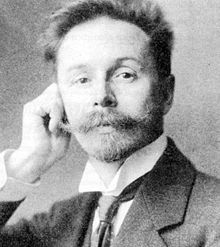 Romance, by Alexander Scriabin
Romance, by Alexander ScriabinTranscribed for Clarinet or Flute or Alto Flute (and Piano) by J. W. Pratt
Parts, PDF $0.00
Alexander Scriabin (1872-1915), the mystic Russian composer with music to match, wrote nine mind-bending orchestral works and myriad mostly miniature piano pieces. He began as a "Russian Chopin" and ended planning a week-long "Mysterium" to be performed in the Himalayas using "an orchestra, a large mixed choir, an instrument with visual effects, dancers, a procession, incense, and... mists and lights" (Wikipedia).
The Romance of 1890, his only chamber work except one variation for string quartet, is nearer the Chopin end of that spectrum, though the piano part adds harmonic and rhythmic complexities not evident from the solo part alone.
- John W. Pratt, Jan. 19, 2016
Please click on the links to download your free PDFs:
Transcription for clarinet required no changes of pitch. Scriabin - Romance - Clarinet
The transcription for flute is raised an octave, except the last five measures. Scriabin - Romance - Flute
The transcription for alto flute raises MM21-24 and MM36-48 an octave. Scriabin - Romance - Alto Flute
The piano score is freely available on IMSLP.org.
Scriabin image courtesy of Wikimedia.org, PD-old.
-
Valerius/Kremser/Pratt - We Gather Together - arr. Brass Ensemble
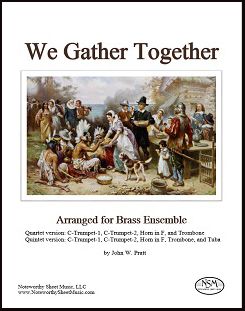 We Gather Together, by Adrianus Valerius
We Gather Together, by Adrianus Valerius
Arranged for Brass Ensemble by John W. Pratt
Quartet version: Score and Parts for C-Trumpet-1, C-Trumpet-2, F Horn, and Trombone;
Quintet version: Score and Parts for C-Trumpet-1, C-Trumpet-2, F Horn, Trombone, and Tuba;Edition includes both Quartet and Quintet versions; PDF $7.99
Wilt heden nu treden, nowadays more commonly known as We Gather Together, is a Christian hymn of Dutch origin composed by Adrianus Valerius and first published in 1626 (imslp.org); it was later harmonized by Eduard Kremser (en.wikipedia.org). In the United States, We Gather Together is the most popular song traditionally associated with the Thanksgiving holiday. The Thanksgiving tradition in the Pratt household goes back as far as John Pratt (b. 1931) can remember, and when it fell to him to play all three stanzas at his family's annual gathering, he got interested in livening it up. He has now created an arrangement of We Gather Together for brass ensemble that lends new excitement and interesting harmonies to this old favorite. The opportunistic half-step modulations introduced to help amateur voices warm up also brighten successive stanzas for brass. The Noteworthy Sheet Music edition includes two variations of this brass arrangement, for quartet or quintet. Some of the parts (in addition to tuba) differ in the quartet and quintet arrangements, and we are including both complete sets of scores and parts in this single publication.
Note that for these publications, the parts should be printed one-sided since they are only one page each and we have not inserted blank filler pages.Click to listen to an mp3 of a computer-generated rendition of the brass quartet arrangement; your live performances will of course be more realistic and appealing.
Brass Quartet: Score, 3 pages; Parts for C-Trumpet-1, C-Trumpet-2, F-Horn, and Trombone, 1 page each. Brass Quintet: Score, 3 pages; Parts for C-Trumpet-1, C-Trumpet-2, F-Horn, Trombone, and Tuba, 1 page each. Total, 18 pages.
Preview -
Bach - Toccata, Adagio, and Fugue - Wind Quartet
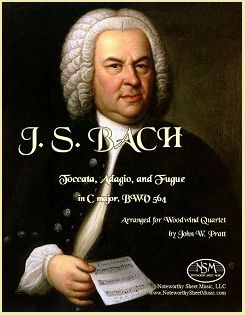 Toccata, Adagio, and Fugue in C major, BWV 564, by J. S. Bach
Toccata, Adagio, and Fugue in C major, BWV 564, by J. S. BachArranged for Woodwind Quartet by John W. Pratt
Score and Parts for Flute, Oboe, Clarinet, & Bassoon, PDF $21.25excerpted from JWP’s © foreword to the edition:
Among J. S. Bach's big organ works, the Toccata, Adagio, and Fugue, BWV 564 is atypical in ways that make it unusually well suited to transcription for woodwind quartet. Unlike most, it has a middle movement, an Adagio with an elaborate and gorgeous melody which lies comfortably for flute and can benefit greatly from the shaded, nuanced dynamics and articulations that a solo flutist can provide. The other winds bring out Bach's beautiful voice-leading in the Adagio's two inner parts and its marching but not martial bass. The four-part Fugue is unusual, too—light and lighthearted, happily adaptable to woodwinds, with no call for great power and, rather than a climactic ending, a fading coda that defies convincing treatment on the organ. The exuberant Toccata starts with an extended manual solo passage... mostly in 32nd notes, which... I felt it would be more effective as a game of frequent handoffs between instruments than as a series of longer individual études. The pedal solo, mostly 16ths, calls for the extra weight of doubling.Click to listen to a computer-generated audio sample from the end of the Toccata into the beginning of the Adagio.
Score, 17 pages; Flute part, 6 pages; Oboe part, 5 pages; Bb Clarinet part, 5 pages; Bassoon part, 4 pages; Total, 46 pages.
Preview
-
Bartók - For Children - arr. for Winds
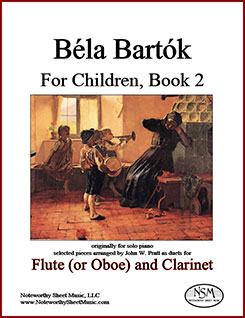 For Children, by Béla Bartók
For Children, by Béla Bartók
piano pieces based on Hungarian and Slovakian folksongsSelected pieces arranged as woodwind duos, trios, or quartets by John W. Pratt and presented in multiple editions, organized by instrumentation and nationality.
Béla Bartók was not only a major composer in a post-Romantic extended tonal style, but he was also a superb pianist with a precise technique, a scholarly explorer of folk music, and a serious pedagog. Folk melodies and harmonies strongly influenced his music, both indirectly and often directly, including many of his orchestral and chamber works, as well as solo piano pieces ranging in difficulty from easy to virtuosic. His For Children (Gyermekeknek,1908-1909, Sz. 42) was written for solo piano, and the original Books 1 and 2 contained 42 pieces after Hungarian folksongs and 43 pieces after Slovakian folksongs, respectively. Besides the usual purposes of music written for children, Bartók sought to broaden their musical experience with, for instance, modal and other scales, and harmonies outside the traditional western canon. For Children is by no means pablum; though the notes may be easy to play, these pieces have a lot else to offer. They were written when Bartók’s folksong research was well under way and his notational efforts at their peak. Students, teachers, and every-day players can make as much of them as they like... as simple tunes for beginners content to learn basic notes and rhythms, or as more advanced studies on articulation, musicality, etc. —extracted from the preface by JWP
John Pratt has arranged selected pieces from the For Children books as various duos, trios, and quartets for wind instruments. As presented originally by Bartók, many of the folksongs are entirely or mostly in two voices, like Bach’s two-part inventions in style if not structure or harmony, and thus convenient for wind duo and no more childish for Bartók than Bach. Many others are also adaptable to duos of flute or oboe and clarinet or bassoon, mostly by spreading the left-hand chords in time. Still others of the For Children pieces are more suitable for a wind trio of flute (or oboe), B-flat clarinet, and bassoon, or a quartet of flute, oboe, B-flat clarinet, and bassoon. To compare the specific songs included in our editions with the complete set arranged for piano available in Bartók’s publications, visit the For Children listing on imslp.org.
All of the NSM editions described below are available as downloadable PDFs. We provide scores, but not separate parts, as all players can easily play off copies of the scores, which are organized for convenient page turns when the PDFs are printed two-sided in their entirety. Click the Preview button to view a page of the score from each edition. To order, in the table at the bottom of this webpage, check the box for the edition you would like to purchase, click Add to Cart, then click Checkout.
► Bartók - For Children, Book 1 - selected pieces arr. as Duets for Flute (or Oboe) and Clarinet
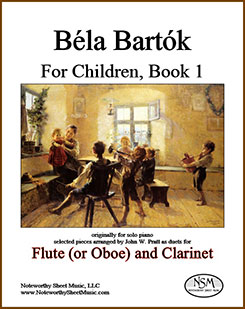 This edition includes 25 pieces from Book 1 arranged as duets; all of them can be played by B-flat clarinet and either flute or oboe, but for six of the pieces we also include alternative versions with octave changes that are better suited to oboe. The pieces included are Nos. 1-15, 22-26, 29, 31, 21, 40, and 42. Click to listen to computer-generated audio samples from the score; audio clips of #11 "Me and the Rain" with flute and clarinet and #32 "Wedding Day and Night" with oboe and clarinet are separated by a brief pause.
This edition includes 25 pieces from Book 1 arranged as duets; all of them can be played by B-flat clarinet and either flute or oboe, but for six of the pieces we also include alternative versions with octave changes that are better suited to oboe. The pieces included are Nos. 1-15, 22-26, 29, 31, 21, 40, and 42. Click to listen to computer-generated audio samples from the score; audio clips of #11 "Me and the Rain" with flute and clarinet and #32 "Wedding Day and Night" with oboe and clarinet are separated by a brief pause.
Score, 26 pages; Total, 30 pages.
Preview: Book 1, Flute (or Oboe) and Clarinet► Bartók - For Children, Book 1 - selected pieces arr. as Duets for Oboe (or Flute) and Bassoon
Score, 21 pages; Total, 24 pages.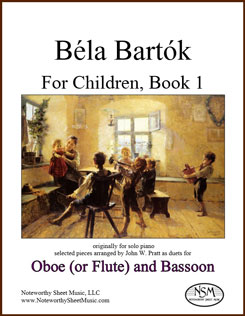 Our oboe (or flute) and bassoon edition includes the same 25 pieces from Book 1 as our flute and clarinet edition described above, except here they are arranged and optimized as duets for oboe and bassoon, with alternative versions better suited for flute and bassoon provided for two of the folksongs.
Our oboe (or flute) and bassoon edition includes the same 25 pieces from Book 1 as our flute and clarinet edition described above, except here they are arranged and optimized as duets for oboe and bassoon, with alternative versions better suited for flute and bassoon provided for two of the folksongs.
Preview: Book 1, Oboe (or Flute) and Bassoon► Bartók - For Children, Book 2 - selected pieces arr. as Duetsfor Flute (or Oboe) and Clarinet

Our Book 2 edition of arrangements for flute (or oboe) and clarinet duo includes 23 pieces: Nos. 1-6, 8, 10-13, 16-20, 22, 25, 26, 29, 31, 35, and 36. All of these pieces can be played by B-flat clarinet and either flute or oboe, but we also include alternative versions that are more suitable for oboe for three of the pieces.
Score, 17 pages; Total, 22 pages.
Preview: Book 2, Flute (or Oboe) and Clarinet► Bartók - For Children, Book 2 - selected pieces arranged as Duetsfor Oboe (or Flute) and Bassoon
Score, 15 pages; Total, 18 pages.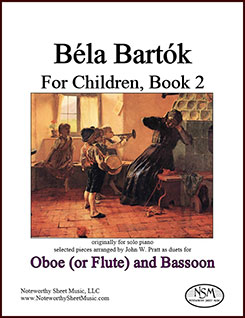 The oboe (or flute) and bassoon edition includes the same 23 pieces from Book 2 described above for flute and clarinet, here arranged and optimized as duets for oboe and bassoon, with an alternative version better suited for flute for one of the pieces.
The oboe (or flute) and bassoon edition includes the same 23 pieces from Book 2 described above for flute and clarinet, here arranged and optimized as duets for oboe and bassoon, with an alternative version better suited for flute for one of the pieces.
Preview: Book 2, Oboe (or Flute) and Bassoon
► Bartók - For Children, Book 1 - selected pieces arranged as Triosfor Flute (or Oboe), Clarinet, and Bassoon
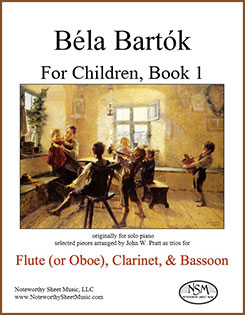 In this trio edition, we present 20 songs from Book 1, including 14 that are also available as duo arrangements in the editions listed above and 6 that are only offered in our trio edition. The pieces are Nos. 1-9, 11, 13-15, 19, 20, 30, 35, 39, 41, and 42. The trios are arranged for flute or oboe, B-flat clarinet, and bassoon. Click to listen to a computer-generated audio sample from #39 "Insect Wedding".
In this trio edition, we present 20 songs from Book 1, including 14 that are also available as duo arrangements in the editions listed above and 6 that are only offered in our trio edition. The pieces are Nos. 1-9, 11, 13-15, 19, 20, 30, 35, 39, 41, and 42. The trios are arranged for flute or oboe, B-flat clarinet, and bassoon. Click to listen to a computer-generated audio sample from #39 "Insect Wedding".Score, 21 pages; Total, 24 pages.
Preview: Book 1, Flute (or Oboe), Clarinet, and Bassoon Trio► Bartók - For Children, Book 2 - selected pieces arranged as Trios for Flute (or Oboe), Clarinet, and Bassoon
Score, 18 pages; Total, 22 pages.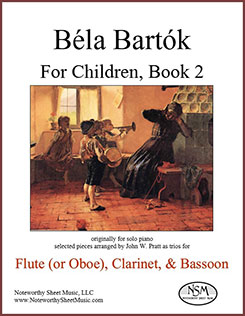 Here Mr. Pratt offers eighteen of Bartók’s Book 2 Slovakian folksongs in arrangements for a woodwind trio of flute or oboe, B-flat clarinet, and bassoon; the pieces included are Nos. 2, 3, 7, 9, 11-14, 16, 17, 21, 25, 26, 28, 29, 32, 33, and 42. Ten of these songs are also included in our duo arrangement publications.
Here Mr. Pratt offers eighteen of Bartók’s Book 2 Slovakian folksongs in arrangements for a woodwind trio of flute or oboe, B-flat clarinet, and bassoon; the pieces included are Nos. 2, 3, 7, 9, 11-14, 16, 17, 21, 25, 26, 28, 29, 32, 33, and 42. Ten of these songs are also included in our duo arrangement publications.
Preview: Book 2 Flute (or Oboe), Clarinet, and Bassoon Trio► Bartók - For Children, Book 1 - selected pieces arranged for Wind Quartet (Flute, Oboe, Clarinet, and Bassoon)
Score, 11 pages; Total, 14 pages.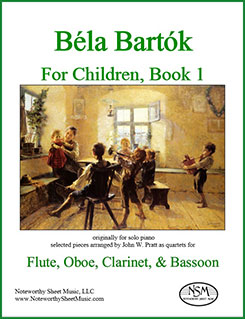 This edition includes eleven of Bartók’s Hungarian folksongs in arrangements for a woodwind quartet of flute, oboe, B-flat clarinet, and bassoon. Two of these songs, Nos. 19 and 20, are also included in our trio arrangement publication, but none are replicated in the duo arrangement editions; the quartet publication includes Book 1 Nos. 16-21, 27, 28, and 36-38.
This edition includes eleven of Bartók’s Hungarian folksongs in arrangements for a woodwind quartet of flute, oboe, B-flat clarinet, and bassoon. Two of these songs, Nos. 19 and 20, are also included in our trio arrangement publication, but none are replicated in the duo arrangement editions; the quartet publication includes Book 1 Nos. 16-21, 27, 28, and 36-38.
Preview: Book 1, Flute, Oboe, Clarinet, and Bassoon Quartet► Bartók - For Children, Book 2 - selected pieces arranged for Wind Quartet (Flute, Oboe, Clarinet, and Bassoon)
Score, 24 pages; Total, 28 pages.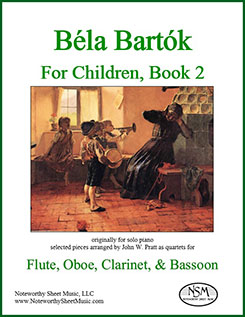 This edition presents seventeen of Bartók’s Book 2 Slovakian folksongs in arrangements for woodwind quartet (flute, oboe, B-flat clarinet, and bassoon). Four of these songs, Nos. 11, 14, 25 and 28, are also included in our trio arrangement publication, and several are included in the duo arrangement editions. The Book 2 songs arranged here as quartets are Nos. 5, 8, 11, 14, 15, 18, 23- 25, 27, 28, 30, 31, 34, 37, 38, and 43. Click to listen to a computer-generated audio sample that consists of ~32” of song #5 Bird in Flight (Theme & part of Var.1, through m34), followed immediately by #18 Former Flame in its entirety.
This edition presents seventeen of Bartók’s Book 2 Slovakian folksongs in arrangements for woodwind quartet (flute, oboe, B-flat clarinet, and bassoon). Four of these songs, Nos. 11, 14, 25 and 28, are also included in our trio arrangement publication, and several are included in the duo arrangement editions. The Book 2 songs arranged here as quartets are Nos. 5, 8, 11, 14, 15, 18, 23- 25, 27, 28, 30, 31, 34, 37, 38, and 43. Click to listen to a computer-generated audio sample that consists of ~32” of song #5 Bird in Flight (Theme & part of Var.1, through m34), followed immediately by #18 Former Flame in its entirety.
Preview: Book 2, Flute, Oboe, Clarinet, and Bassoon Quartet
-
Haydn - Early Sonatas - arr. as Wind Duos
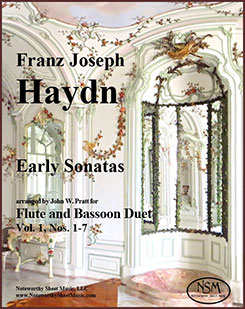 Early Sonatas, by Franz Joseph Haydn
Early Sonatas, by Franz Joseph HaydnArranged as Woodwind Duets by John W. Pratt (originally for keyboard)
Even the earliest of Franz Joseph Haydn’s keyboard sonatas have great rhythmic variety and vitality, and are delightful when played with verve. They are mostly in two voices, and even where not, their early classical harmonies are easily conveyed by two instruments. They incorporate few pianistic effects and lie comfortably within range for flute or oboe and bassoon or clarinet, and thus make natural woodwind duets of lively, interesting music. All these editions include a score and parts. Those wishing to consult the keyboard editions of the Haydn sonatas, from which Mr. Pratt created his arrangements, can find them at imslp.org. (Adapted from J. W. Pratt’s preface to the edition.)
Cover image “Decorations of the Sala Terrena, Eszterházy Palace in Fertőd, Hungary“ by Monyesz, Creative Commons Attribution-Share Alike 3.0 Unported license.
--------------------------------------------------------------------------------
►Early Haydn Sonatas arranged by John W. Pratt as Duets for Flute and Bassoon, Vol. 1, Nos. 1-7Score, 26 pages; Flute part, 14 pages; Bassoon part, 11 pages; Total, 54 pages; PDF $14.75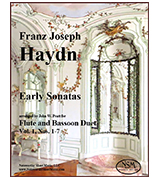 This edition includes seven of Haydn's early keyboard sonatas arranged as duets for flute and bassoon. John Pratt's creation of these duets was inspired by a desire to offer two of his music colleagues some new music to enjoy, as they had exhausted their available flute and bassoon duo repertoire. These duets work nicely for winds and are fun to play. For a sense of how they sound when played by flute and bassoon, click below to listen to a computer-generated audio excerpt: the first 45” of the recording come from the Andante of Sonata 5 (Hob. XVI:11), followed by 25” of the Sonata 6 (Hob. XVI:10) Presto. Alternatively, the flute part can be played on oboe, making these sonata arrangements nicely amenable to oboe and bassoon duos as well.
This edition includes seven of Haydn's early keyboard sonatas arranged as duets for flute and bassoon. John Pratt's creation of these duets was inspired by a desire to offer two of his music colleagues some new music to enjoy, as they had exhausted their available flute and bassoon duo repertoire. These duets work nicely for winds and are fun to play. For a sense of how they sound when played by flute and bassoon, click below to listen to a computer-generated audio excerpt: the first 45” of the recording come from the Andante of Sonata 5 (Hob. XVI:11), followed by 25” of the Sonata 6 (Hob. XVI:10) Presto. Alternatively, the flute part can be played on oboe, making these sonata arrangements nicely amenable to oboe and bassoon duos as well.
Preview: Vol.1, Nos. 1-7, Flute and Bassoon--------------------------------------------------------------------------------
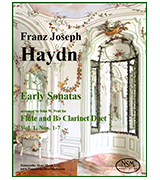 ►Early Haydn Sonatas arranged by John W. Pratt as Duets for Flute and B-flatClarinet, Vol. 1, Nos. 1-7
Please see the description above for Volume 1 of Haydn’s early keyboard sonatas arranged as duets for flute and bassoon. Our flute and clarinet edition of Vol. 1 contains the same seven sonatas, here arranged for flute (or oboe) and B-flat clarinet. Click to listen to a computer-generated audio clip of two excerpts: the first 27” of the recording come from the Andante of Sonata 1 (Hob. XVI:8), followed by 26” of the Scherzo from Sonata 3 (Hob. XVI:9).Score, 26 pages; Flute part, 14 pages; Clarinet part, 11 pages; Total, 54 pages; PDF $14.75
►Early Haydn Sonatas arranged by John W. Pratt as Duets for Flute and B-flatClarinet, Vol. 1, Nos. 1-7
Please see the description above for Volume 1 of Haydn’s early keyboard sonatas arranged as duets for flute and bassoon. Our flute and clarinet edition of Vol. 1 contains the same seven sonatas, here arranged for flute (or oboe) and B-flat clarinet. Click to listen to a computer-generated audio clip of two excerpts: the first 27” of the recording come from the Andante of Sonata 1 (Hob. XVI:8), followed by 26” of the Scherzo from Sonata 3 (Hob. XVI:9).Score, 26 pages; Flute part, 14 pages; Clarinet part, 11 pages; Total, 54 pages; PDF $14.75
Preview: Vol.1, Nos. 1-7, Flute and Clarinet -
Mozart - Sinfonia Concertante - Fl/Cl/Pf
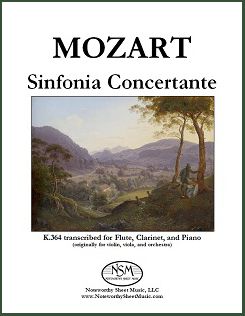 Sinfonia Concertante, K.364, by Wolfgang Amadeus Mozart
Sinfonia Concertante, K.364, by Wolfgang Amadeus MozartTranscribed for Flute, Clarinet, and Piano by John W. Pratt
(originally for Violin, Viola, and Orchestra)
Piano Score, Flute & Clarinet Parts, PDF $17.99
Excerpted from the Foreword by J. W. Pratt: "The idea that every piece, especially a major one, can be satisfactorily transcribed for whatever instruments one would like is one I firmly reject. However, a trio arrangement of this Sinfonia Concertante for flute, clarinet, and piano can, I believe, capture and present in a new light many of the wonders of this great work, even the wonders of its sonorities..... In the arrangement here, the flute and clarinet almost always play either a solo part or an orchestral part with only octave changes..... For the piano, on the other hand, straightforward orchestral reduction is often ineffective and unsatisfying, and that would certainly be true here, even with the flute and clarinet taking some wind parts. I have attempted instead to find natural piano "orchestrations" as alternatives to Mozart's orchestral layouts, especially where the full orchestra is playing..... Such effects, often heightened on returns, are better suited to the piano's capabilities and its role as a member of a trio than a straightforward reduction would be..... The music available for flute, clarinet, and piano includes surprisingly few major works. The purpose of our arrangement is to add a significant piece to this repertoire and to enable players and listeners to enjoy Mozart's magnificent Sinfonia Concertante in a new way."
Score, 41 pages; Flute part, 18 pages; Clarinet part, 17 pages; Total, 82 pages.
Preview -
Bloom - Ablaze She Came in the Dream - Flute, Viola, and Guitar
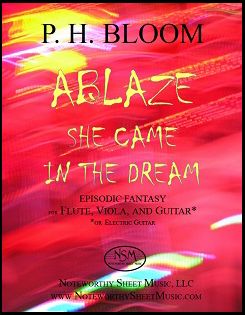 Ablaze She Came in the Dream, by Peter H. Bloom
Ablaze She Came in the Dream, by Peter H. BloomContemporary Composition for Flute, Viola, and Guitar (or Electric Guitar)
Flute, Viola, & Guitar Parts and Score, PDF $22.97
Flutist Peter H. Bloom is no stranger to Noteworthy Sheet Music or to our customers, as he has contributed several popular arrangements and transcriptions to our catalog and he also serves as an editorial consultant for NSM.
Now we are very pleased to offer this newly published (2014) and highly intriguing original composition by Mr. Bloom entitled Ablaze She Came in the Dream. The piece comprises eleven brief episodes written for the unusual trio combination of flute, viola, and guitar (or electric guitar). Ablaze is intended to serve as an interpretive vehicle for the performers and thus should be executed freely and expressively. The work is suitable for advanced players.
Click to access a recording of the premier performance of Ablaze which took place on November 21, 2014 in Boston, MA, as part of the Church of the Advent Library Concert Series. The performance features Peter H. Bloom on flute, Frank Grimes on viola, and Anastasiya Dumma on electric guitar.
Score, 23 pages; Flute Part, 11 pages; Guitar Part, 12 pages; Viola Part, 12 pages; Total, 66 pages.
Preview
====================================
We also offer a professionally-printed hard copy edition of Ablaze She Came in the Dream for $45.88 plus a $5.95 shipping and handling fee. Due to prohibitively high international shipping rates, we ship print editions only to addresses in the USA. Please use the Contact Us form to let us know which hard copy publication(s) you would like to purchase, along with your email contact information and USPS mailing address. We will then send you a PayPal invoice for the sale and, once we receive notice from PayPal that you have paid for the item(s), we will ship your music to the address provided for delivery in 7-10 business days. -
Beach - 3 Compositions - Alto Flute & Piano
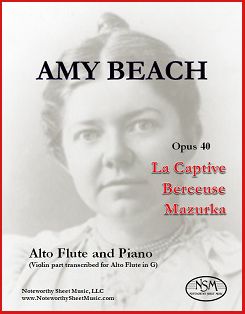 3 Compositions, Op.40, by Amy Beach
3 Compositions, Op.40, by Amy BeachTranscribed for Alto Flute and Piano by C.A.Vater
Piano Score and Alto Flute Part, PDF $10.50
Amy Marcy Cheney was born in Henniker, New Hampshire in 1867 and began composing music at the age of four. Initially home-schooled as a pianist, she continued her music studies in Boston and made her professional debut as a pianist at age 16. She later became a soloist with the Boston Symphony Orchestra. At 18, she married the prominent Boston physician Dr. Henry Harris Aubrey Beach and began using "Mrs. H. H. A. Beach" as her professional name. She continued to perform occasionally as a pianist, but for many years she focused her musical skills primarily on composing. After her husband's death in 1910, Mrs. Beach resumed her performing career, beginning with a three year tour of Europe, while also continuing to write music. Her works were received with great acclaim, and Amy Beach became one of America's leading composers and the first American woman composer to achieve widespread recognition in the United States and abroad. During her lifetime, she wrote more than 150 numbered works, spanning a variety of genres that included piano pieces, chamber music, orchestral works, sacred choral music, and a great many songs.
Amy Beach's 3 Compositions for Violin and Piano, Op.40, were first published in 1898. Written in the romantic style, the three pieces are (1) the beautiful but sombre La Captive, (2) a lovely, lyrical Berceuse, and (3) a lively but still tender Mazurka. In addition to alto flute transcriptions of all three pieces, we include in our edition a version of the Mazurka transcribed for flute and piano (score and part), for those wishing to give this option a try as well.
Alto Flute part, 4 pages; Piano/Alto Flute Score, 10 pages;
Alternate "Mazurka" Flute part, 2 pages; "Mazurka" Piano/Flute Score, 5 pages;
Total, 29 pages.
Preview -
Tchaikovsky - Arab Dance - Alto Flute & Harp/Piano
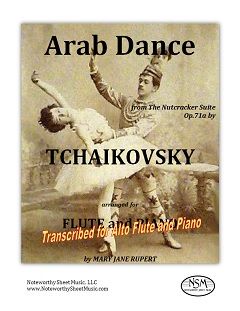 Arab Dance, by P. Tchaikovsky
Arab Dance, by P. TchaikovskyArranged for Flute and Harp or Piano by Mary Jane Rupert
Transcribed for Alto Flute by C.A.Vater
Alto Flute Part and Harp or Piano Score, PDF $7.99
Mary Jane Rupert's arrangement of The Nutcracker for flute and harp or piano includes all of the pieces from the original Suite, Op. 71a, except the Overture. Dr. Rupert stayed as close as possible to the original orchestration, in terms of key, harmony, register, and color. Originally published in 1988, the arrangement was re-edited by Dr. Rupert in 2013 for publication as separate flute/piano and flute/harp editions by Noteworthy Sheet Music. After creating the new flute editions, Noteworthy Sheet Music's editors realized that one of the pieces of the suite in particular, Arab Dance, would work beautifully on alto flute. We created an alto flute transcription of the flute part, both for ourselves and for our alto flutist friends.
We offer separate versions of the score for piano or harp, although in the case of the Arab Dance the harp-specific notation is minimal compared to some of the other pieces contained in the complete edition of The Nutcracker arranged for flute and harp.
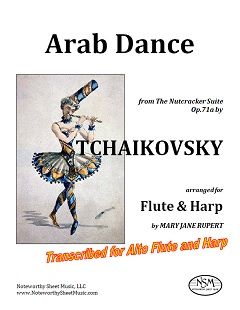 Alto Flute & Harp Edition: Harp score, 6 pages; Alto Flute part, 1 page; Total, 10 pages. $7.99
Alto Flute & Harp Edition: Harp score, 6 pages; Alto Flute part, 1 page; Total, 10 pages. $7.99
Preview Alto Flute & Piano Edition: Piano score, 6 pages; Alto Flute part, 1 page; Total, 10 pages. $7.99
Alto Flute & Piano Edition: Piano score, 6 pages; Alto Flute part, 1 page; Total, 10 pages. $7.99
Preview -
Vercoe – Duos – 2 Flutes, Oboes, or Clarinets
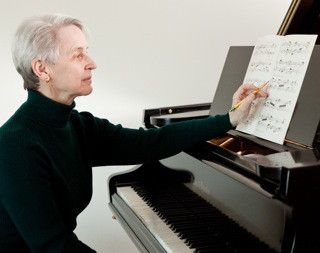 Woodwind Duos, by Elizabeth Vercoe
Woodwind Duos, by Elizabeth VercoeOriginal Compositions for 2 Flutes, 2 Oboes, or 2 Clarinets, $0.00 (free!)
Elizabeth Vercoe's Duos for woodwinds are available as free downloads from the composer's own website at http://www.elizabethvercoe.com/. Dr. Vercoe kindly offered to allow Noteworthy Sheet Music, LLC to make these duets available from our website as well.
The Duos, in versions for two flutes, two oboes, or two clarinets, are "fun and quite easy. They are suitable for intermediate students."
Photo of Elizabeth Vercoe courtesy of Caroline Alden.
Just click on the links below to download the Duos at no charge; each PDF includes all 5 short duets:
Duos for 2 Flutes
Duos for 2 Oboes
Duos for 2 Clarinets -
Foster - Old Folks; Oh! Susanna - Vo/Pf/Fl/Vc
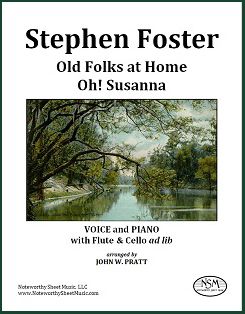 Old Folks at Home and Oh! Susanna, by Stephen Foster
Old Folks at Home and Oh! Susanna, by Stephen FosterArranged with Flute and Cello ad lib by John W. Pratt
Flute Parts, Cello Parts, Voice Parts, and Piano Scores ― PDF $7.99
The following excerpts are taken from John W. Pratt's foreword to the edition:
When a Golden Oldie comes to mind, Doo-dah! Doo-dah!
Comic, sad, or any kind, Oh! Doo-dah-day!
Jeanie, Swanee, Kentucky, Joe, Doo-dah! Doo-dah!
Beautiful, dreamy, fast, or slow, Oh! Doo-dah-day!
I'll bet I know who wrote it, he wrote them night and day,
Stephen Foster wrote it, he'll never go away.
Stephen Foster was born in Lawrenceville, Pa., on July 4, 1826...He wrote over 200 songs, including 135 parlor songs, 28 minstrel songs, and 21 hymns and Sunday school songs. A remarkable number are memorable, as the ditty above will attest to anyone with anything like my background. One wonders why. The harmonies and rhythms are basic, as are the forms and rhyme schemes (see above), the music is repetitious, and the vocal range rarely goes outside an octave (a great benefit for community singing). Yet the fit is so natural and the pacing so well judged that the songs are ideally effective and diabolically catchy. Foster is perhaps, though on a different plane, the Mozart of his field...
For a pianist playing several stanzas at a sing-along, Foster's songs do become a little dull. But their very simplicity, repetitiousness, and familiarity abet variation as, again on a different plane, chorales serve Bach chorale preludes. Like chorale preludes, the piano parts here always incorporate the melody, so they can be played solo or to accompany amateur singers. It struck me that they could be enhanced by optional flute parts. After writing them, I discovered that, according to his brother Morrison, Foster himself "delighted in playing accompaniments on the flute...As the song went on he would improvise...the most beautiful variations upon its musical theme." If Foster's improvisations were like the one his brother published, however, they just varied the melody itself in the manner of the period. My game is more ambitious, as you will easily see. I added optional cello parts, mostly for color, as in the Haydn trios but superficially more interesting for the cellist. (Again we are on a different plane, of course.)
"Oh! Susanna," one of the best-known American songs by anybody, is Foster's "Erlkönig." (Speak of different planes!) With its nonsensical lyrics and polka beat, it is clearly comical, and I treated it accordingly. It was written in Cincinnati, possibly for a social club, first performed at an ice cream saloon in Pittsburgh in 1847, and published in 1848. When no American song had sold over 5,000 copies, it sold over 100,000. It earned Foster only $100, but its popularity led to a publisher's offer, convincing him to become a professional songwriter, America's first.
"Old Folks at Home" established Foster as a truly American composer. It was written in 1851 for a blackface troupe whose leader paid Foster about $15 to be credited for it. When almost finished, Foster asked his brother for "a good name of two syllables for a Southern river." He rejected Yazoo and Pedee, but was delighted with Swanee, a shortening of Suwanee, a small river in Florida which his brother found in an atlas. Though about a slave's nostalgia for home, I find its theme universal and melancholy and I resisted the temptation to jazz it up. Please try, at least, a slowish tempo.
― John W. Pratt, May 27, 2013 ©
Flute parts, 2 pages; Cello parts, 2 pages; Voice parts, 2 pages; Scores, 7 pages; Total, 18 pages.
Preview -
Kalliwoda - In die Ferne - Voice, Violin/Flute, & Piano
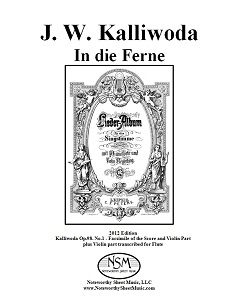 In die Ferne, Op.98, No.1, by J. W. Kalliwoda
In die Ferne, Op.98, No.1, by J. W. KalliwodaFacsimile Edition plus Transcription of Violin part for Flute by C.A.Vater
Score for Violin, Voice, & Piano, Violin Part, Flute Part, PDF $5.99
Johann Wenzel Kalliwoda (1801‒1866) was a Bohemian violinist, conductor, and composer who spent much of his career in Donaueschingen, where he served as the conductor of the court orchestra for Prince Karl Egon II of Fürstenberg. Kalliwoda composed numerous works, including operas, symphonies, pieces for piano, violin and orchestra, and chamber music.
Kalliwoda's song In die Ferne (Far Away) was published in a nineteenth century collection of lieder, along with several songs by Hauptmann and Reinecke. The vocal range of In die Ferne extends from E4 to G#5, and thus is well-suited for either soprano or mezzo-soprano. Our edition contains "enhanced" facsimiles of the original score (violin, voice, and piano) and violin part, plus a transcription of the violin part for flute created using a modern music notation program. Therefore, In die Ferne may be performed using the accompaniment of either violin or flute, along with the voice and piano.
Score, 6 pages; Violin and Flute parts, 1 page each; Total, 12 pages.
Preview
===============
U.S. customers may purchase professionally-printed hard copies of In die Fernefor $10.18 plus a $5.95 shipping and handling fee. Please use the Contact Us form to let us know which print edition(s) you would like to purchase, along with your contact information and your USPO mailing address. -
Bach - Prelude & Fugue - String Quintet
 Prelude and Fugue, WTC Book I, No.22, by J. S. Bach
Prelude and Fugue, WTC Book I, No.22, by J. S. BachTranscribed for String Quintet by John W. Pratt, PDF $16.00
Though written for keyboard, this Prelude and Fugue from Book I of Bach's Well-Tempered Clavier is wonderfully adaptable to an instrumental quintet. The Prelude, with its serene harmonic pacing, reveals an almost Schubertian sublime beauty, and the magical counterpoint of the five-part fugue emerges crystal-clear. The challenge for the players, as well as the pleasure, lies in ensemble achievements, not technical difficulties in individual parts.
Score, 6 pages; Parts, 2 pages each, for Violin I, Violin 2, Viola 1, Viola 2, and Cello
with an alternate part for Cello in place of Viola 2; Total, 20 pages.
Preview
-
Hauptmann - Lieder - Voice, Violin/Flute, Piano
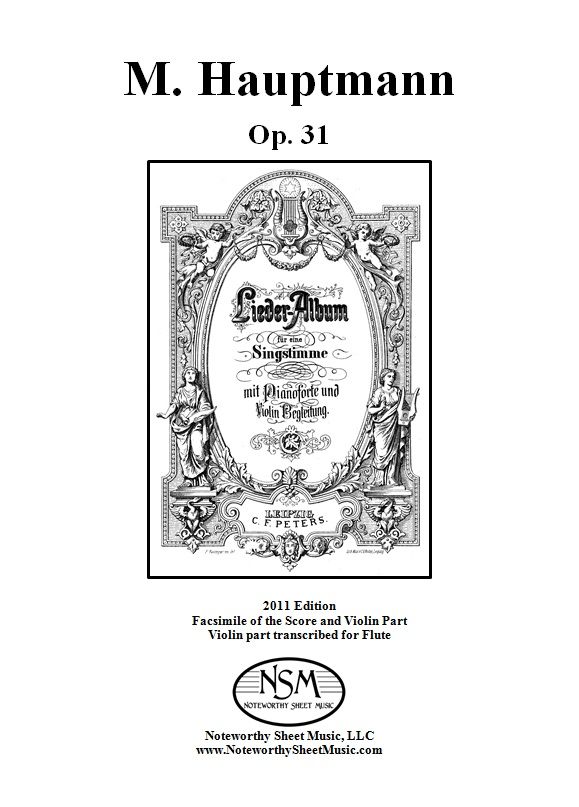 Meerfahrt, Nachtgesang, and Der Fischer, Op.31, by M. Hauptmann
Meerfahrt, Nachtgesang, and Der Fischer, Op.31, by M. HauptmannFacsimile Edition plus a Transcription of the violin part for Flute by C.A.Vater
Score for Violin, Voice, & Piano, Violin Part, and Flute Part, PDF $18.75
Moritz Hauptmann (1792-1868) was a renowned music theorist, pedagogue, violinist, and composer. In 1842, at Mendelssohn's recommendation, he was appointed cantor at the Thomasschule and professor of composition at the newly founded Leipzig Conservatory. Hauptmann published a major scholarly work on music theory in 1853, "Die Natur der Harmonik und Metrik" (The Nature of Harmony and Meter), as well as some 60 compositions.
Hauptmann's Op.31 comprises three lovely songs scored for voice with accompaniment of violin and piano: No.1, Meerfahrt (Sea Voyage); No.2, Nachtgesang (Night Song); and No.3, Der Fischer (The Fisherman). The vocal range extends from B3 to G5, and thus is well-suited for mezzo-soprano. These pieces were published by C. F. Peters as part of a larger volume, now in the public domain, entitled "Lieder-Album für eine Singstimme mit Pianoforte und Violin Begleitung". Our edition contains an "enhanced" facsimile of the original, plus a new transcription of the violin part for flute created using a modern music notation program. The three songs may be performed with comparable gratification utilizing the accompaniment of either violin or flute, along with the voice and piano.
Score, 15 pages; Violin part, 5 pages; Flute part, 5 pages; Total, 29 pages.
Preview -
Dressler - Portrait Charmant - Flute (or Vn) & Piano
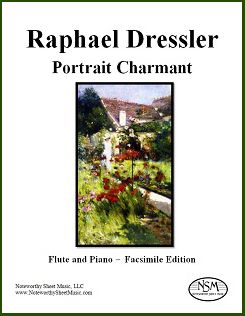 Portrait Charmant, by Raphael Dressler
Portrait Charmant, by Raphael DresslerGassett Collection - Facsimile Edition by C.A.Vater/Noteworthy Sheet Music
Part for Flute or Violin and Piano Score, PDF $3.00
Raphael Dressler (1784-1835) was a well-known Austrian flutist and composer. He wrote more than 100 compositions for flute and published a popular flute method book, New and Complete Instructions for the Flute. His career included a position as first flutist in the Kärntnerthor Theater orchestra in Vienna and many years as a teacher and performer in London. Dressler's Portrait Charmant is the fifth of his Douze Thèmes Favoris pour Pianoforte et Flûte (ou Violon). The piece is a short work, simple yet indeed charming, and playable by flutists (or violinists) and pianists of many skill levels. A favorite of ours, Portrait Charmant can also be played effectively as a solo work for flute or violin alone.
For additional information about the Gassett Collection, please see see our article An Introduction to the Gassett Collection.
Piano score, 3 pages; Flute or Violin part, 1 page; Total, 8 pages.
Preview -
Nicholson - Coolun - Fl or Fl & Pf or Fl & Hp
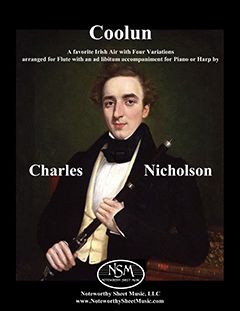 Coolun, A favorite Irish Air with Four Variations, by C. Nicholson
Coolun, A favorite Irish Air with Four Variations, by C. NicholsonGassett Collection - Facsimile Edition by C.A.Vater/Noteworthy Sheet Music
Piano Score and Flute Part, PDF $9.99
Charles Nicholson (1795-1837) was a masterful, hugely popular, and highly influential English flutist and teacher, famous for his individual style and powerful tone. Among Nicholson's compositions are 13 fantasies and 15 airs with variations, including Coolun. A favorite Irish Air with Four Variations arranged for the Flute with an ad libitum Accompaniment for the Piano Forte, or Harp. The "Coulin" or "Coolan" was described in an 1833 letter to the editor of the Dublin Penny Journal (www.libraryireland.com) as "an air, that once heard even in the earliest infancy, can never be forgotten—a melody which breathes the most touching tenderness and exquisite sensibility, and the memory of which, enables the Irish to hear Scotland's 'O, Nanny wilt thou gang with me,'—or her 'Banks and Braes,' without envious repinings."
Nicholson's consummate rendition of Coolun is highly effective when played either as a solo for flute alone or by flute with accompaniment of piano, lever harp, or pedal harp. The Gassett Collection print from which our facsimile was created consists of a score for piano forte and flute, without a separate flute part. The flute part included in our edition was created from the score using a modern music notation software program.
Noteworthy Sheet Music's publication of Coolun was favorably reviewed by Katherine Borst Jones in the January, 2014 issue of Flute Talk magazine. You can read the review, reproduced on our website for your convenience, or at Flute Talk (subscribers).
For additional information about the Gassett Collection, please see see our article An Introduction to the Gassett Collection.
Piano score, 6 pages; Flute part, 5 pages; Total, 15 pages.
Preview
==============================================================================
To order our print edition of Coolun, A Favorite Irish Air arranged for Flute and Piano or Harp for $16.98 plus a $5.95 shipping and handling fee to addresses in the USA. Use the Contact Us form to let us know which hard copy publication(s) you would like to purchase, along with your email contact information and USPS mailing address. We will then send you a PayPal invoice for the sale and, once we receive notice from PayPal that you have paid for the item(s), we will ship your music to the address provided.
-
Brahms - Trio in A Minor - Alto Flute
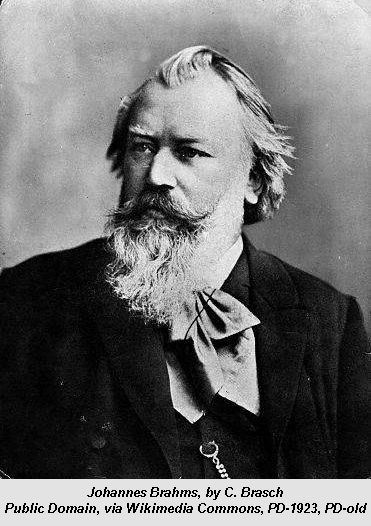 Trio in A Minor, Op.114, by Johannes Brahms
Trio in A Minor, Op.114, by Johannes BrahmsTranscribed for Alto Flute, Cello, and Piano by Carol A. Vater
Alto Flute Part, PDF $5.99
Johannes Brahms (1833-1897) composed the Trio in A Minor for Clarinet, Cello and Piano in 1891 and subsequently created an alternate arrangement in which viola was substituted for the clarinet. The expressive qualities, range, and rich, dark tones of the alto flute are well-suited to this beloved piece. In creating this transcription of the clarinet part for alto flute, every effort has been made to maintain the spirit and character of the original composition. We provide here the Brahms Trio in A minor alto flute part; the piano and cello parts are readily available in the public domain as free pdf downloads of the original score and parts. Here is a link to one such source: Piano Score and Cello Part
Alto Flute part, 13 pages; Total, 15 pages.
Preview -
Bruch - Eight Pieces - Alto Flute
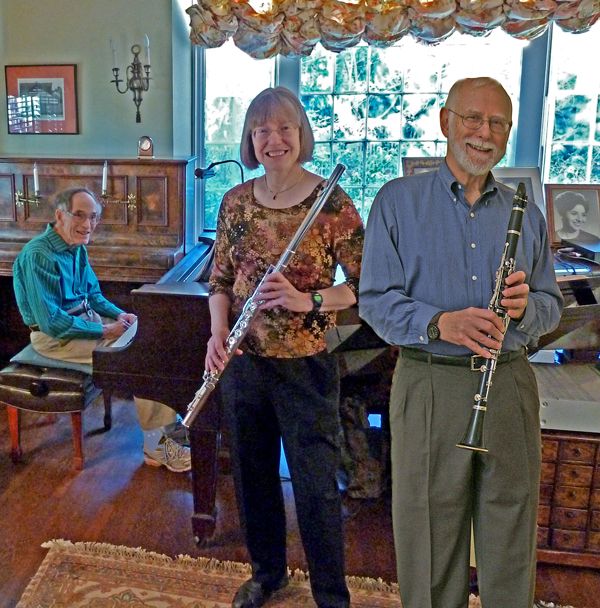 Acht Stücke, Op.83, by Max Bruch
Acht Stücke, Op.83, by Max BruchTranscribed for Clarinet, Alto Flute, and Piano by Davies, Pratt, and Vater
Alto Flute Part, PDF $9.98
Originally scored for clarinet, viola, and piano (or violin, cello, and piano), Bruch's Acht Stücke (Eight Pieces) adapts nicely for a trio with clarinet, alto flute, and piano. Bruch's beautiful melodies are well served by the rich tones of the alto flute.
In creating this transcription of the viola part for alto flute, we have taken great care to maintain the spirit and character of the original instrumentation. We provide here the alto flute part. The piano and clarinet parts are readily available in the public domain as free pdf downloads of the score and parts. Here is a link to one such source: Piano Score and Clarinet Part
Alto Flute part, 17 pages; Total, 19 pages.
Preview